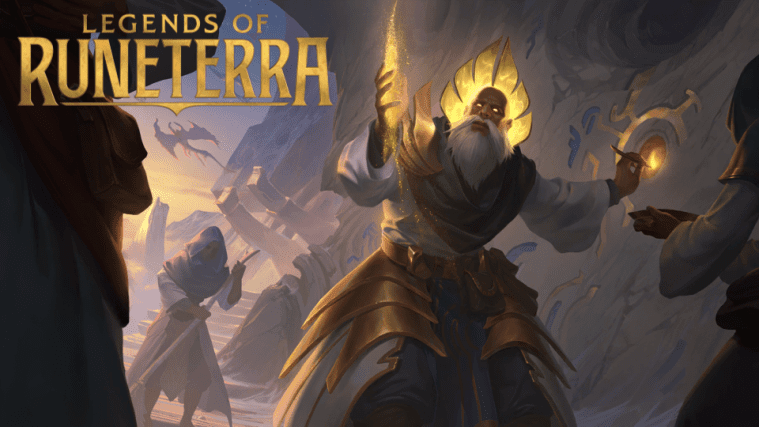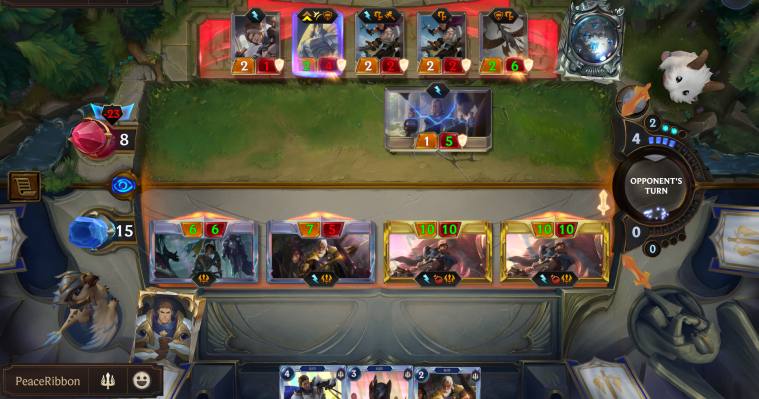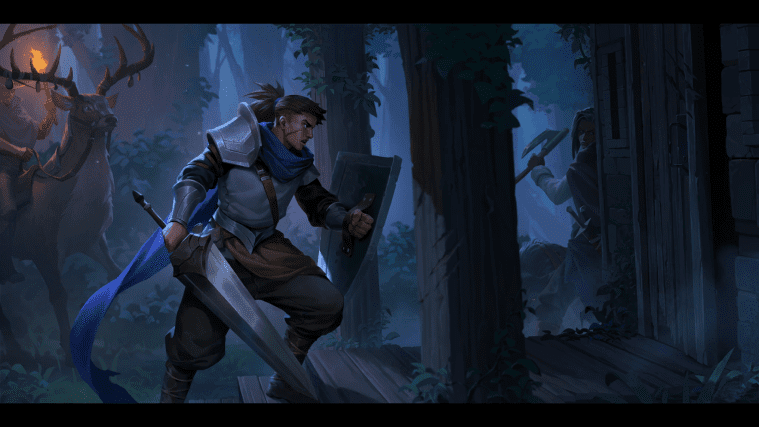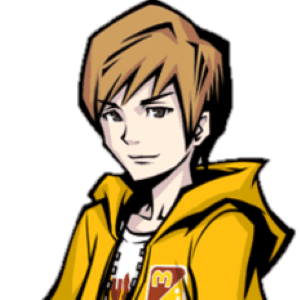If you told me back when I had written my Legends of Runeterra 2022 report that it would be one of the most popular articles I would ever write, I would have chuckled at the idea that a wide berth of people cared about my card game curiosities. But against all odds that article did serious numbers, and I even received fan mail asking me more about the state of the game! I am super grateful for all of our readers’ support, and repaying that kindness with another update article seems only fair. It’s actually surprising how much has changed since the last article, and you might find it pretty interesting too. I should put a disclaimer though that between graduating college, getting a job, and playing other games to review among many other pursuits, I have found myself less inclined to play these past 12 months with the same vigilance which I played before. I apologize if you were still looking for the opinion of someone who hits level 10+ on the weekly vault year-round, but times are different and interest levels can only stay obsessively high for so long. With that out of the way, allow me to walk you through the major expansions and changes in Legends of Runeterra since my last article. Please note that this review was written during the 4.1 patch and may not reflect the absolute current state of the game by the time it is published.

After patch 3.2 where our previous examination left off, new content wasn’t terribly voluminous, however there were a few notable patches where balance updates were made and even all-new cards were introduced as a way of infusing certain archetypes and regions with more tools they may have been lacking. For instance in patch 3.6 on April 27th 2022 we got the spells For Glory! helping reputation, Inner Beast for Udyr decks, and Might of the Vanguard for my beloved Elites. This wouldn’t be a trend that stayed especially consistent over the year, but keep it in mind anyways because it will be important at the end of our examination.
The first major patch came May 25th 2022 with the start of the Worldwalker expansion of patch 3.8, which would eventually be completed in patch 3.11 with the second half of the set. After Beyond the Bandlewood definitely cut off the potential of an 11th region coming to the game, Worldwalker was left in the interesting position of showing us what expansions would look like in a post-region expansion era of the game. The answer given by Worldwalker was… to add the 11th region. Kind of. The main new mechanic added in this era of the game is Runeterran Champions, a champion card which when placed in your deck becomes a region in and of itself. While locking you out of picking a second region as normal (or hilariously any regions at all if you pick two Runterran Champions), you get to pick from a selection of themed cards regardless of what region they appear in, and having the champion in your deck at all often provides some kind of passive benefit. At first we sensed this new type of card would open up new ways to look at older cards, but in the end many of their deck building costs serve to stifle these Champions into the same set of cards each time they are built around. Additionally because the developers often achieve the regionless theme by sprinkling their tools across some or all of the ten true regions (not too dissimilar from Bandle City actually) the game as a whole has its once stark region differentiations blurred. I kind of get the sense that they wanted Runeterra Champions to land with the same impact as getting a new region in a sustainable format, but as things have progressed they’ve ultimately come to feel like a disappointment as there’s almost always only one kind of way for them to be built around. Characters with new mechanics in existing regions generally run the risk of suffering the same problem to some extent, but at least they exist within the normal rules of the game so they have the possibility of being built in truly innovative ways, whereas Runeterran Champions are ironically boxed in by their disregard for said rules (kinda like rebels in real life now that I think about it).
As for the expansion itself, Worldwalker had a few interesting cards but ultimately is probably remembered for some very frustrating new designs. The main culprits in particular were Bard and Kai’sa, both of whom were heavily nerfed by the start of the next expansion, but they share the same fundamental problem of being overly swingy in their design without much counterplay. Bard is capable of planting bonuses in your deck which when drawn give extra stats to units in hand, and it was incredibly common for him to be run in decks with high-statted units anyways so you had to deal with impossibly resilient units who gained too much power from literally sitting in hand for free. Kai’sa on the other hand had a relatively interesting idea of accumulating keywords by copying them from allies, but the copied abilities applied even to Kai’sas in your deck so if she ever got spellshield she basically won the game on the spot thanks to her ridiculously powerful level 2 effects. These additions were unlike anything seen in the game before, and many players sensed a growing trend of making Champions who had stylish and easy to use effects over being properly balanced. The fact that these were eventually nerfed brought me some consolation, but the fact of the matter is that on the whole Worldwalker made quite a few mistakes when it came to reading what players liked out of the game.
Thankfully what they got more right in the expansion was single player modes. The Path of Champions roguelite mode got a major overhaul to make it more sustainable for long term engagement, featuring new rewards systems and mechanics to make these crazy runs better feel like they open up to new rewards. It did take them some time to iron out the champion acquisition system so that players could play who they wanted, and I’d be lying if I said that the overhaul removing the stories which birthed my bonus article didn’t sting, but overall the update was markedly improved. The other big return was of the labs game modes in the second half of the expansion, bringing back three popular game modes for our memeing pleasure. These modes haven’t rotated out since they were added back in and I do think their return would have felt more impactful if they introduced a new lab to advertise it, but the fact that they are here at all has definitely done wonders to soothe my fears about the game forcing players to the ranked grind (even if lately all I’ve really been playing are the standard matches).

The other half of 2022’s big content updates began on August 31st with the release of the first set of The Darkin Saga in patch 3.14, which would see three releases with the last one coming on December 7th in patch 3.21. This expansion continued to explore much of the same design space as Worldwalker, but the most significant change to the game during this time was the introduction of a new card type called equipment. Equipment is essentially an iteration on the Attach mechanic which the Yuumi suit of cards brought to the game, but with more widespread access across regions and the ability to be cast with spell mana. You stick them on your units to gain new stats and effects, and if the unit dies the equipment goes back into your hand instead of disappearing. Of all the things I said in my previous Legends of Runeterra articles predicting Yuumi as a top tier Champion was easily the biggest misfire, but I honestly feel validated in my prediction indirectly thanks to the introduction of equipment.
If I may take the most dedicated players on a trip down memory lane, remember when Deny used to cost 3 mana to play? What made that card so powerful as a spell lockout tool was that you could cast it using only your stored spell mana, meaning that you could make full use of your primary mana curve while still threatening Deny’s pressure. The relationship between Attach units and equipment is much the same, as subtleties aside Attach is purely a worse version of equipment for cutting into your mana pool in a way equipment simply doesn’t. And this already would make equipment pretty overturned when combined with its theoretically infinite value as a recurring card, but the supporting cards and Champions really pushed it over the edge. Between Vayne rushing us down with seemingly infinite free attacks (Irelia flashbacks) and the Cultist/Darkin cards that generate super high value for just existing in the same decks as equipment have led to some truly insane metas which required a lot of balance patches to make their power manageable. I guess while I’m here I should also pay lip service to Seraphine for being an absolute RNG nightmare that led to the meta most antithetical to Runeterra’s original promises, even without being designed around equipment (although good on them for making that disaster of a champion into a likable character this time around).
However if you asked me which of the two expansions I liked more this year, it would be this one. For one they added the first Legends of Runeterra exclusive Champion, Norra. While also a bit of a swingy RNG character she has at least avoided the extreme problems of Bard and Seraphine, and it’s just cool to see more original content for the game even if Norra herself isn’t my cup of tea. We also got Kayle sporting a design that was very well integrated into the existing mechanics of the game as opposed to cramming new ones into it, and I’m excited to see what she and future similar champions do for the game as a whole. There were also a few new Gauntlet modes added around this period which focus on building decks specifically with cards from older expansions which is nice, though I stopped playing Gauntlets a long time ago since their time-limited nature make them a lot of trouble to play around with casually.
And those were really the big updates for Legends of Runeterra in the past two years. More recently they’ve added more clout features and whatnot but on the whole nothing too crazy. So is the game worth playing still? Well most of the things I like about it are certainly still intact between being generous with free rewards to make playing the decks you want easy, having an engaging and complex core battle system, and being full of top-notch artwork. I even bought a skin for my favorite champion, and can confirm that even the cosmetic options have gotten a lot better with time. However I think it’s clear to everyone at this point that the game has been out long enough that its competitors have gained the courage to create things that draw players away from this title’s dominance of its early years. While the game isn’t unsupported by any means it is adjusting to match things people like about other titles, which means that if you’re expecting the game promised in the original announcement video one to one you really won’t find it here. We aren’t a totally roll-of-the-dice kind of card game yet, but things have trended that way ever since Bandle City came out and the developers and even some players are considerably more convinced that it’s better for the game. If anything I think the best advice I can give for prospective players is to give the new year some time to progress and see how things pan out, because the game is currently in another transitional period where they intend to follow a new cadence of balance, variety booster, expansion, repeat. What is at stake is both whether this cadence will be sustainable for the downsized development team in the long term to keep players engaged, and whether they are willing to learn for the many, many frustrating card designs that came out over the last year. There’s plenty that could go really well for Legends of Runeterra right now, but it’s up to the developers to deliver on the quality we expect from them.

Before I end off the article, while as usual it’s hard to draw any particular spiritual messages from LoR as a whole, there were plenty of additions to the game from a thematic standpoint which I feel compelled to talk about. As the title of the second expansion implies we got a lot of emphasis on the darkin characters from League, which while technically distinguished from demons in canon lore are very obviously just demons by another name. Worldwalker also featured in its second expansion the Champion Evelynn, who is a formal Runeterra demon and features some of the most inappropriate artwork and voice lines in the game thanks to being inspired by succubi. This doesn’t surprise me particularly and I’ve made it evidently clear that a few spooks in my video games are fine as long as there’s a degree of balance with good characters and a proper understanding of the spooks’ villainy, however it does reflect some of our modern American culture’s strange fascinations with corruption and the occult that I find bit worrying and sad. I don’t think we’ll see too many similar characters in the near future of the game since we exhausted pretty much all of the major ones from League’s canon thankfully (cry about it Fiddlesticks simps), but it is now a portion of the game’s roster worth critical examination if you have any worries about this sort of content affecting you or your loved ones.
The other portion of artistic content within the game I wanted to talk about is funnily enough the darkin’s polar opposite, Kayle and the celestial spirits of justice. Among all of the things added in The Darkin Saga Kayle was definitely the greatest source of balance against all the freaky darkins, being a character based on popular depictions of angels. What most people took as noticeable from this addition however were the various beings in the celestial army of justice, especially the Aspect of Justice Mihira, as they seem to take more ques from the idea of the “biblically-accurate angels” which has taken off in recent times. In all honesty the fact that the art team chose to study this material is rather welcome and I appreciate the diversity in execution, but I think at the end of the day their execution on both kinds of angelic inspirations they pulled from are just a little… off?
To explain what I mean by this, first let me remind us of the understanding that angels are beings of pure spirit, with no bodily forms for us to technically imagine at all as we are now. It is true that the Bible offers some description of them, but really I’m not sure that words can communicate the full truth of what angels look like in the same way we cannot really describe to one another the shape of things like ‘intelligence’ (or maybe you might call it ‘mind’). The depictions within the Bible Itself are also both thoroughly based in ancient Jewish mythological symbolism and are meant to communicate the otherworldliness of God’s servants, so it’s difficult to justify calling the biblical descriptions empirical ones. Furthermore if you subscribe to it, St. Thomas Aquinas proposed that in order for angels as pure spirits to differentiate themselves from one another, they would need to each be their own species anyways, so to point to any one depiction and say “this is what angels look like” only seems accurate in the sense that one particular angel might look like that.
To me then the purpose of depicting angels in art is not to communicate what they are in an absolute sense because that is impossible, but rather what can be understood about them in a symbolic sense. In this light I think a good depiction of an angel should communicate their place of righteousness in the cosmological order, and their bond with humanity as fellow creations of God, yet also not so relatable to us that they feel too accessible and worldly. I think this applies to both the humanoid and fantastical depictions we have seen in the past. On the humanoid side of things, the ever famous St. Michael the Archangel painting by Guido Reni serves as a good example. The righteousness of St. Michael’s position is very clear and you can find a point of connection in his human-like appearance, but he is also depicted with a deep sense of authority and power which would be foolish to try and violate. On the other side of the spectrum, the seraphim depicted on the roof of the Hagia Sophia also work well as their six wings surrounding their heads may not be especially relatable to a person, but the art still communicates their righteousness through the pleasing beauty of their forms without sacrificing their otherworldly presence.
For the most part, the angels in Legends of Runeterra fail to meet this sort of depiction in both ends of the spectrum. On one hand you can feel some of the Saint Michael inspirations in the way Kayle is drawn, but at the end of the day schlock angel characters like her are always going to radiate this cringy pinup girl energy which robs them of any stately, divine bearing. Even a simple redesign of her armor to make it communicate “I am a powerful arm of the heavens” more than it does “I look smokin’ hot” would have done wonders but alas. On the other hand the various angelic creatures and Mihira herself lack a sense of companionship, and it feels like their designs are meant to scare the viewer rather than inspire wonder for the heavens. Good angel art of the second kind is always going to be somewhat strange, but even they need a sense of warmth or majesty to help the viewer understand their heroic mission, and making them look like eldritch monsters borders on intellectual dishonesty about the subject. I guess what I mean to say with all of this is that Legends of Runeterra has given me a lot to think about when it comes to angelic depictions, and my answer to it is that regardless of what kind of art you prefer, a good depiction will soothe and inspire the viewer when thinking about it to some extent. This expansion is just a microcosm of how sexy marketing and edgy ‘literalism’ alike are not the ideal we are aiming for. And yes, I know Runeterra is not earth and doesn’t have to abide by the Catholic understanding of angels if it doesn’t want to, but I do believe that the liberties it takes can indirectly put ideas about our own spiritual realities into peoples’ heads, and making angels incessantly scary or ‘available’ is a problematic idea to propagate. Anyways that’ll be all from me on Legends of Runeterra today. I definitely enjoy logging in a few times a month to tune my deck up and will keep an eye on the game, but we’ll see if the game changes enough to merit another follow up article. Assuming I’m not already in a monastery by then.
Original Scoring: 80%
Gameplay: 5/5
Story: 2/5
Art and Graphics: 5/5
Music: 3/5
Replayability: 5/5
Morality/Parental Warnings
Legends of Runeterra features characters and creatures inspired by many different types of fantasy and real-world inspirations, and much of it is intertwined with archetypes like magic, monsters, undead spirits, and various cosmic forces as mentioned in the review proper, and could be frightening to younger audiences. A few of the characters are dressed in revealing clothing. A few voice lines include light swearing, and a few characters also have voice lines/artwork that suggest LGBT relationships. Some of the implied story touches thematically on real-world issues, sometimes very clumsily. Online interactions come with all the usual warnings, though communication with players not on your friends list is restricted to emotes. The game features in-game purchases, so take care not to overspend.
Additional Notes: Between the Darkin and Evelynn additions to the game, there are a lot more demon themed characters in the game now, and while they aren’t demons in a literal sense Evelynn and her follower cards in particular draw upon lore surrounding sucubi and incubi. The voicelines and artwork associated with them is naturally quite inappropriate, with the developers themselves stating that their inclusion taught them the limits of what they were allowed to depict.
If you’ve been enjoying the work the team at Catholic Game Reviews have been doing, consider becoming one of our patrons over on Patreon. Ad revenue is notoriously small as ever, so any monthly contribution you can make would be very well appreciated. And if you’ve ever wanted to request a game for us to review, dedicated support through Patreon is the way to make it happen. Even if you can’t support us though, allow me to thank you for your continued readership over the past few years, and God bless.
